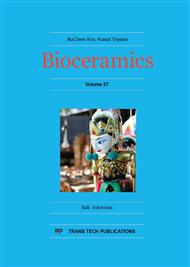[1]
Amini, A. R., C. T. Laurencin, and S. P. Nukavarapu. Bone tissue engineering: recent advances and challenges. Critical reviews in biomedical engineering 40. 5 (2007) 363.
DOI: 10.1615/critrevbiomedeng.v40.i5.10
Google Scholar
[2]
Sugiura, Hiroaki, et al., In vivo biological responses and bioresorption of tilapia scale collagen as a potential biomaterial. Journal of Biomaterials Science: Polymer Edition 20. 10 (2009) 1353-1368.
DOI: 10.1163/092050609x12457418396658
Google Scholar
[3]
Kureshi, A., et al., Alignment hierarchies: engineering architecture from the nanometre to the micrometre scale, J. R., Soc. Interface 7 (2010) S707-S716.
DOI: 10.1098/rsif.2010.0346.focus
Google Scholar
[4]
Feng, Bai, et al., The effect of pore size on tissue ingrowth and neovascularization in porous bioceramics of controlled architecture in vivo, Biomedical Materials 6. 1 (2011) 015007.
DOI: 10.1088/1748-6041/6/1/015007
Google Scholar
[5]
Davidenko, Natalia, et al., Biomimetic collagen scaffolds with anisotropic pore architecture, Acta biomaterialia 8. 2 (2012) 667-676.
DOI: 10.1016/j.actbio.2011.09.033
Google Scholar
[6]
Yunoki, S., et al., Control of pore structure and mechanical property in hydroxyapatite/collagen composite using unidirectional ice growth, Materials Letters 60. 8 (2006) 999-1002.
DOI: 10.1016/j.matlet.2005.10.064
Google Scholar
[7]
K. M. Pawelec, A. Husmann, S. M. Best, R. E. Cameron, A design protocol for tailoring ice-templated scaffold structure, J. R., Soc. Interface (2014) DOI: 10. 1098/rsif. 2013. 0958.
DOI: 10.1098/rsif.2013.0958
Google Scholar
[8]
M. Papee., et al., Ice Nucleation and Growth in Supercooled Water Films Condensed on a Hydrophobic Surface, Nature 203 (1964) 1343-1345.
DOI: 10.1038/2031343a0
Google Scholar
[9]
Tran, Nhiem, and Thomas J. Webster, Increased osteoblast functions in the presence of hydroxyapatite-coated iron oxide nanoparticles, Acta Biomaterialia, 7. 3 (2011) 1298-1306.
DOI: 10.1016/j.actbio.2010.10.004
Google Scholar
[10]
Liu, Meili, et al., Effect of nano‐hydroxyapatite‐coated magnetic nanoparticles on axonal guidance growth of rat dorsal root ganglion neurons, Journal of Biomedical Materials Research Part A 103. 9 (2015) 3066-3071.
DOI: 10.1002/jbm.a.35426
Google Scholar
[11]
Covaliu, I. C., et al., Synthesis and characterization of a hydroxyapatite coated magnetite for potential cancer treatment, Rev. Chim. 60 (2009) 1254-1257.
Google Scholar
[12]
Ramanujan, Raju V., and Y. Y. Yeow, Synthesis and characterisation of polymer-coated metallic magnetic materials, Materials Science and Engineering: C 25. 1 (2005) 39-41.
DOI: 10.1016/j.msec.2004.04.001
Google Scholar
[13]
Felisberto, Marcos DV, and Mauro Laranjeira, Preparation and characterization of hydroxyapatite-coated iron oxide particles by spray-drying technique, Anais da Academia Brasileira de Ciências 81. 2 (2009) 179-186.
DOI: 10.1590/s0001-37652009000200004
Google Scholar
[14]
Deb, S., et al., Synthesis and characterization of biocompatible hydroxyapatite coated ferrite, Bulletin of Materials Science 26. 7 (2003) 655-660.
DOI: 10.1007/bf02706759
Google Scholar
[15]
Rehman, I., and W. Bonfield, Characterization of hydroxyapatite and carbonated apatite by photo acoustic FTIR spectroscopy, Journal of Materials Science: Mat. in Med. 8. 1 (1997) 1-4.
DOI: 10.1023/a:1018570213546
Google Scholar
[16]
Figueiredo, M. M., A. G. Martins, and J. A. F. Gamelas, Characterization of bone and bone-based graft materials using FTIR spectroscopy, INTECH Open Access Publisher (2012).
DOI: 10.5772/36379
Google Scholar
[17]
Adamescu, Adrian, Density Functional Theory Calculations on Hydrated Dimethylarsinic Acid and Iron Oxide Clusters, (2012) http: /scholars. wlu. ca/etd/1125.
Google Scholar
[18]
Tombacz, E., et al., Magnetite in aqueous medium: coating its surface and surface coated with it, Romanian Reports in physics 58. 3 (2006) 281-286.
Google Scholar
[19]
Porter, Michael M., et al., Magnetic freeze casting inspired by nature, Materials Science and Engineering: A 556 (2012) 741-750.
Google Scholar
[20]
Guo, Cheng, and Laura J. Kaufman, Flow and magnetic field induced collagen alignment, Biomaterials 28. 6 (2007) 1105-1114.
DOI: 10.1016/j.biomaterials.2006.10.010
Google Scholar
[21]
O'Brien, Fergal J., et al., Influence of freezing rate on pore structure in freeze-dried collagen-GAG scaffolds, Biomaterials 25. 6 (2004) 1077-1086.
DOI: 10.1016/s0142-9612(03)00630-6
Google Scholar


